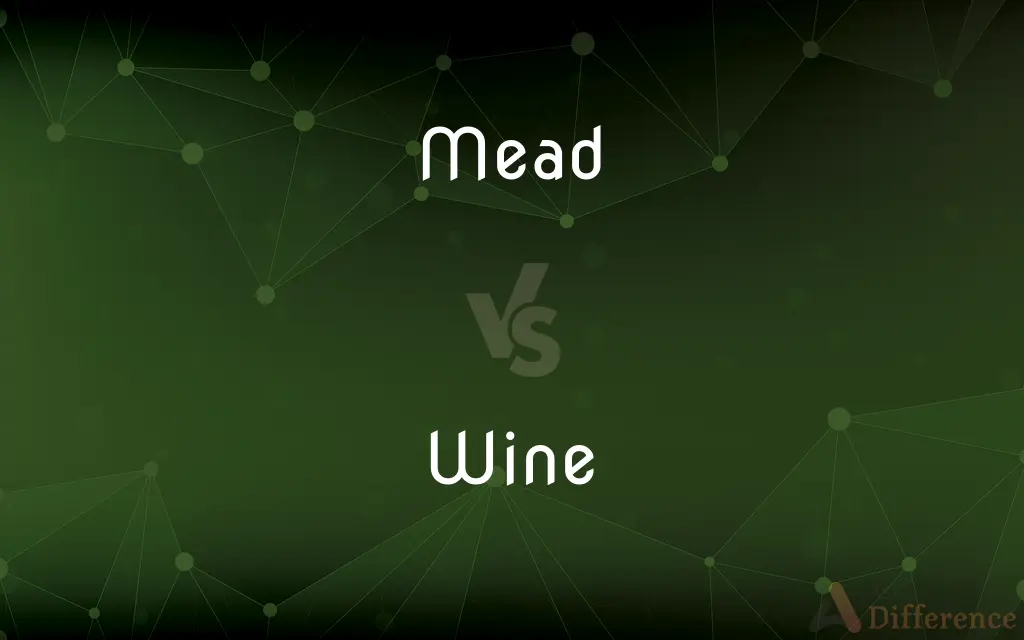Mead vs. Wine — What's the Difference?
Edited by Tayyaba Rehman — By Maham Liaqat — Published on September 27, 2024
Mead is a fermented honey drink, rich in sweetness and history, while wine is made from fermented grapes, offering a variety of tastes and aromas.

Difference Between Mead and Wine
Table of Contents
ADVERTISEMENT
Key Differences
Mead, often referred to as "honey wine," is made by fermenting honey with water, sometimes with fruits, spices, grains, or hops. The flavors, sweetness, and alcohol content can vary greatly based on the ingredients and fermentation process. Whereas wine is primarily made from fermented grapes, and its characteristics depend heavily on the type of grape, the climate where it's grown, and the winemaking process. This leads to a vast range of flavors from dry to sweet, and still to sparkling wines.
The history of mead stretches back thousands of years, making it one of the oldest alcoholic beverages known to humanity. It has been consumed across various cultures and continents, often associated with ancient rituals and celebrations. On the other hand, wine also boasts a rich history, deeply ingrained in many civilizations, especially in the Mediterranean region, where it has been both a daily beverage and a ceremonial drink since ancient times.
Mead's production process can be more straightforward than that of wine, as it requires fewer steps and can be made in a home setting with minimal equipment. While wine production is more complex, involving precise grape cultivation, harvesting, crushing, fermenting, and aging processes, which often require specialized equipment and conditions.
In terms of alcohol content, mead can range widely from about 3.5% to over 20% alcohol by volume (ABV), depending on the fermentation length and additional ingredients. Wine, however, typically ranges from 8% to 15% ABV, with some fortified wines reaching up to 20% ABV.
The cultural significance of mead is notable in Norse and Celtic mythology, where it is often associated with poetry, wisdom, and immortality. Wine, however, has played a pivotal role in religious ceremonies, particularly in Christianity, and has been celebrated in literature, art, and society throughout Western history.
ADVERTISEMENT
Comparison Chart
Base Ingredient
Honey
Grapes
Historical Origin
Ancient, predating most other alcoholic beverages
Ancient, with significant roots in the Mediterranean
Alcohol Content
3.5% - >20% ABV
8% - 15% ABV, some fortified wines up to 20% ABV
Production Process
Simpler, can be made at home
Involves cultivation, crushing, fermenting, aging
Cultural Significance
Associated with Norse and Celtic mythology
Integral to religious ceremonies, literature, and art
Compare with Definitions
Mead
A fermented beverage made from honey, water, and sometimes fruits, spices, or grains.
He brewed a batch of mead with wildflowers for a unique taste.
Wine
Wine's flavor is influenced by grape variety and terroir.
This wine has a complex flavor profile due to its unique terroir.
Mead
Known for its versatility in sweetness and flavor.
She preferred dry mead, enjoying its subtle honey notes.
Wine
An alcoholic drink made by fermenting grapes.
The sommelier recommended a wine that perfectly complemented our meal.
Mead
Alcohol content can vary widely.
This mead has a high ABV, making it stronger than most wines.
Wine
Comes in various styles including red, white, rosé, and sparkling.
She loves exploring different types of wine, from crisp whites to bold reds.
Mead
Often associated with ancient history and mythology.
Mead was mentioned in Norse legends as the drink of gods.
Wine
Subject to an elaborate production process.
The winery's meticulous production process ensures high-quality wine.
Mead
Can be still, carbonated, or sparkling.
For the celebration, they popped open a bottle of sparkling mead.
Wine
Essential to many cultures and cuisines around the world.
Wine is central to French dining culture, pairing with every course.
Mead
An alcoholic beverage made from fermented honey and water.
Wine
A beverage made of the fermented juice of any of various kinds of grapes, usually containing from 10 to 15 percent alcohol by volume.
Mead
A fermented drink made of water and honey with malt, yeast, etc.; metheglin; hydromel.
Wine
A beverage made of the fermented juice of any of various other fruits or plants.
Mead
A drink composed of sirup of sarsaparilla or other flavoring extract, and water. It is sometimes charged with carbonic acid gas.
Wine
Something that intoxicates or exhilarates.
Mead
Made of fermented honey and water
Wine
An alcoholic beverage made by fermenting grape juice, with an ABV ranging from 5.5–16%.
Wine is usually stronger than beer.
"Wine improves with age but I improve with wine," she slurred as she slid gracefully beneath the table.
Wine
An alcoholic beverage made by fermenting other substances, producing a similar ABV.
...dandelion wine, rice wine, plum wine...
Wine
The expressed juice of grapes, esp. when fermented; a beverage or liquor prepared from grapes by squeezing out their juice, and (usually) allowing it to ferment.
Wine is a mocker, strong drink is raging, and whosoever is deceived thereby is not wise.
Bacchus, that first from out the purple grapeCrushed the sweet poison of misused wine.
Wine
A liquor or beverage prepared from the juice of any fruit or plant by a process similar to that for grape wine; as, currant wine; gooseberry wine; palm wine.
Wine
The effect of drinking wine in excess; intoxication.
Noah awoke from his wine.
Wine
Fermented juice (of grapes especially)
Common Curiosities
Can mead have a higher alcohol content than wine?
Yes, mead can have a wider range of alcohol content, sometimes exceeding that of wine.
What is mead made from?
Mead is made from honey, water, and may include fruits, spices, or grains.
How does wine differ from mead in terms of base ingredients?
Wine is made from fermented grapes, whereas mead is made from fermented honey.
How is the alcohol content of wine determined?
It depends on the fermentation process and the sugar content of the grapes.
What are the main types of wine?
Main types include red, white, rosé, and sparkling wines.
What historical significance does wine hold?
Wine has deep historical roots, especially in Mediterranean cultures, and has been significant in religious and social contexts.
How does the taste of mead compare to wine?
Mead tends to be sweeter with a broader flavor profile, while wine's taste varies widely depending on the grape and production method.
Is the production process of mead simpler than that of wine?
Generally, yes. Mead can be simpler to produce than wine, often requiring less specialized equipment.
Are there different types of mead?
Yes, mead can vary from still to sparkling, and from dry to sweet, depending on its ingredients and fermentation process.
How does terroir affect wine?
Terroir, the environment where grapes are grown, significantly impacts the flavor and quality of wine.
Can the flavor of mead change over time?
Yes, like wine, mead can develop more complex flavors as it ages.
Can both mead and wine be made at home?
Yes, both can be made at home, though wine might require more specific conditions and equipment.
What role does mead play in mythology?
Mead is often associated with ancient myths, especially in Norse and Celtic cultures, symbolizing wisdom and immortality.
Is there a preferred temperature for serving mead compared to wine?
Serving temperatures can vary; mead is often served slightly chilled or at room temperature, similar to wine, depending on its style.
What is the cultural significance of wine in modern times?
Wine remains a symbol of sophistication and pleasure, deeply embedded in culinary and social traditions worldwide.
Share Your Discovery

Previous Comparison
Direct Addressing Mode vs. Indirect Addressing Mode
Next Comparison
Blind Spot vs. Yellow SpotAuthor Spotlight
Written by
Maham LiaqatEdited by
Tayyaba RehmanTayyaba Rehman is a distinguished writer, currently serving as a primary contributor to askdifference.com. As a researcher in semantics and etymology, Tayyaba's passion for the complexity of languages and their distinctions has found a perfect home on the platform. Tayyaba delves into the intricacies of language, distinguishing between commonly confused words and phrases, thereby providing clarity for readers worldwide.













































